By John Treadwell Dunbar ——Bio and Archives--August 16, 2011
Travel | CFP Comments | Reader Friendly | Subscribe | Email Us
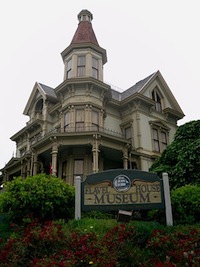 Standing near Fort Stevens looking out across the big blue Pacific on the extreme northwest corner of the Oregon Coast near Astoria where the mighty Columbia River empties into the sea I thought to myself: “No wonder the Japanese lost the war.” It was in the dark of night on June 12, 1942, when an Imperial submarine surfaced and lobbed 17 shells in the general vicinity of the fort before slinking off having inflicted no serious injury to speak of, their aim was that bad.
Things quieted down after that, for a while. The Fort Stevens I remember wasn't at war back in 1978. A hulking mass of abandoned concrete military bunkers out in the woods near the shore, it welcomed our unfettered exploration with not a soul in sight. Back then we camped at will and enjoyed miles of empty pristine beaches where me and my gal stripped and frolicked under a hot August sun in cold rolling waves, big ones, that roared ashore in foaming predictability.
Standing near Fort Stevens looking out across the big blue Pacific on the extreme northwest corner of the Oregon Coast near Astoria where the mighty Columbia River empties into the sea I thought to myself: “No wonder the Japanese lost the war.” It was in the dark of night on June 12, 1942, when an Imperial submarine surfaced and lobbed 17 shells in the general vicinity of the fort before slinking off having inflicted no serious injury to speak of, their aim was that bad.
Things quieted down after that, for a while. The Fort Stevens I remember wasn't at war back in 1978. A hulking mass of abandoned concrete military bunkers out in the woods near the shore, it welcomed our unfettered exploration with not a soul in sight. Back then we camped at will and enjoyed miles of empty pristine beaches where me and my gal stripped and frolicked under a hot August sun in cold rolling waves, big ones, that roared ashore in foaming predictability.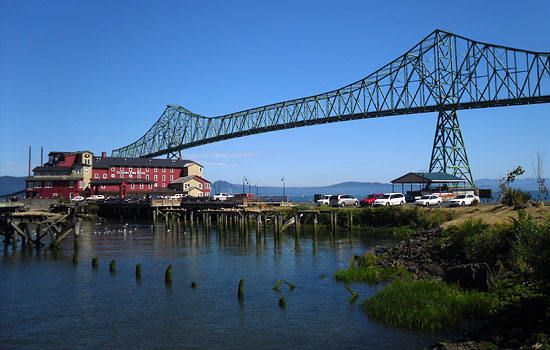 A small city of 10,000, Astoria's architecture reflects a long maritime tradition, a feast of restored Victorian homes and large, old commercial buildings. Residential communities sprawl across the face of “San-Francisco-steep” hills that overlook the long and flat and narrow commercial district and sort-of famous waterfront. Astoria claims the most buildings listed on the National Historic Register in Oregon, per square foot, however many that is. Even on suicidal, rainy gray days that account for all the lush green vegetation, a forgiving eye brings out the best in Astoria like the beautiful Flavel House Museum on 8th Street – the former 1885 Queen Anne home of Captain George Flavel – late-Victorian opulence carved up with exotic woodwork and a really big turret before turrets became silly.
Another historic gem worth noting is the 1925 Italian Renaissance-style Liberty Theater where silent films and vaudeville acts were the rage. But if you’re looking for the old Astoria Theater where Clark Gable performed (big ears, little mustache, starred in “Gone With the Wind”) before his rise to cinematic fame, don't bother. It's gone.
A small city of 10,000, Astoria's architecture reflects a long maritime tradition, a feast of restored Victorian homes and large, old commercial buildings. Residential communities sprawl across the face of “San-Francisco-steep” hills that overlook the long and flat and narrow commercial district and sort-of famous waterfront. Astoria claims the most buildings listed on the National Historic Register in Oregon, per square foot, however many that is. Even on suicidal, rainy gray days that account for all the lush green vegetation, a forgiving eye brings out the best in Astoria like the beautiful Flavel House Museum on 8th Street – the former 1885 Queen Anne home of Captain George Flavel – late-Victorian opulence carved up with exotic woodwork and a really big turret before turrets became silly.
Another historic gem worth noting is the 1925 Italian Renaissance-style Liberty Theater where silent films and vaudeville acts were the rage. But if you’re looking for the old Astoria Theater where Clark Gable performed (big ears, little mustache, starred in “Gone With the Wind”) before his rise to cinematic fame, don't bother. It's gone.
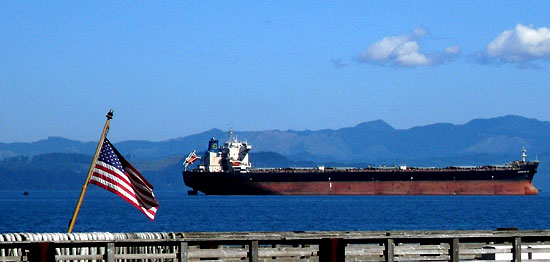 A lip-smacking tale starring Viggo Mortenson, Charlize Theron and Robert Duvall, “The Road” (2009) was filmed here and there and in different local spots. “The Road” is an end-of-the-world Cormac McCarthy saga where the only thing left to eat on earth are slow people, i.e., the ones who didn't run fast enough. To keep the meat fresh, captured humans are caged and devoured in stages, here a leg, there an arm, a fresh tourniquet to stop the leak; you get the picture. And Sean Penn did a commendable job directing “Into the Wild,” shot in part, a small part, somewhere around here. This too is a food-themed romp about twenty-something Christopher McCandless who walked off into the Alaskan wilderness to find himself and starved to death instead, stranded in a rusty old bus parked on the wrong side of a raging river not far from Denali National Park.
A lip-smacking tale starring Viggo Mortenson, Charlize Theron and Robert Duvall, “The Road” (2009) was filmed here and there and in different local spots. “The Road” is an end-of-the-world Cormac McCarthy saga where the only thing left to eat on earth are slow people, i.e., the ones who didn't run fast enough. To keep the meat fresh, captured humans are caged and devoured in stages, here a leg, there an arm, a fresh tourniquet to stop the leak; you get the picture. And Sean Penn did a commendable job directing “Into the Wild,” shot in part, a small part, somewhere around here. This too is a food-themed romp about twenty-something Christopher McCandless who walked off into the Alaskan wilderness to find himself and starved to death instead, stranded in a rusty old bus parked on the wrong side of a raging river not far from Denali National Park.
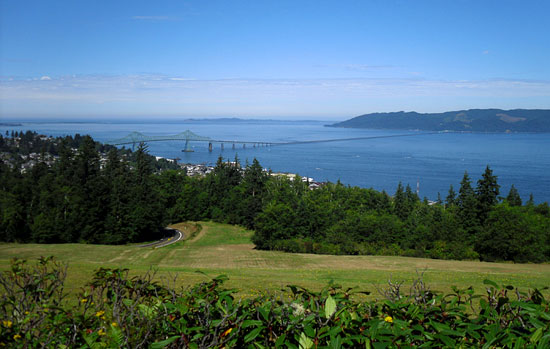 There's plenty to keep you busy in Astoria if your timing is right and you look for it. You can start with the Columbia River Maritime Museum which Frommer's Oregon called one of the “best museums in the state.” Located on the waterfront, it's the state's official maritime museum celebrating the region's maritime legacy with a vast collection of nautical artifacts and a wealth of information.
There's plenty to keep you busy in Astoria if your timing is right and you look for it. You can start with the Columbia River Maritime Museum which Frommer's Oregon called one of the “best museums in the state.” Located on the waterfront, it's the state's official maritime museum celebrating the region's maritime legacy with a vast collection of nautical artifacts and a wealth of information.
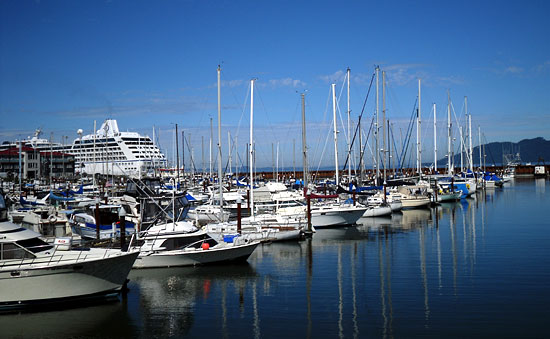 If you don't mind rain, and oh, man, does it ever rain, don your slicker and show up in February for the increasingly popular Fisher Poets Gathering that features art exhibits, workshops, writers, musical groups and yes, poets, celebrating fish, fishing, the fishing industry, and things fishy. Got crabs? If not, swing by in late April for all things crabby at the annual Crab, Seafood and Wine Festival, yet another shindig that dishes up crab melts, crab cocktails, crab cakes and crab fritters and other creepy creatures of the sea. And wine. With over 200 vendors and lots of entertainment it won't be long before you'll have crabs crawling out of your ears, and elsewhere.
If you don't mind rain, and oh, man, does it ever rain, don your slicker and show up in February for the increasingly popular Fisher Poets Gathering that features art exhibits, workshops, writers, musical groups and yes, poets, celebrating fish, fishing, the fishing industry, and things fishy. Got crabs? If not, swing by in late April for all things crabby at the annual Crab, Seafood and Wine Festival, yet another shindig that dishes up crab melts, crab cocktails, crab cakes and crab fritters and other creepy creatures of the sea. And wine. With over 200 vendors and lots of entertainment it won't be long before you'll have crabs crawling out of your ears, and elsewhere.
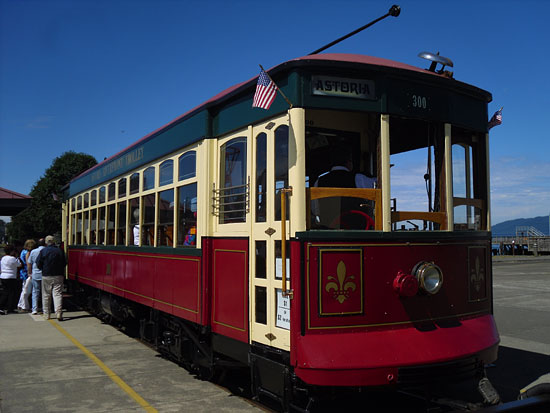 If you can't make to the 40-year-old Scandinavian Mid-Summer Festival in June where they eat, drink and dance the Scandinavian two-step, then wait for August and the Astoria Regatta Festival, a venerated tradition since 1894 and the oldest festival for white people in the Northwest. Parades, sailboat races, concerts, classic cars, a street dance, great food and a salmon barbeque,... there's enough going to even get me interested.
If you can't make to the 40-year-old Scandinavian Mid-Summer Festival in June where they eat, drink and dance the Scandinavian two-step, then wait for August and the Astoria Regatta Festival, a venerated tradition since 1894 and the oldest festival for white people in the Northwest. Parades, sailboat races, concerts, classic cars, a street dance, great food and a salmon barbeque,... there's enough going to even get me interested.
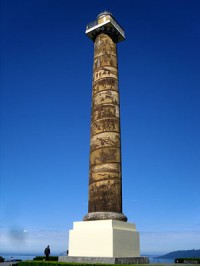 And if the Regatta doesn't float your boat, then strap on your sweaty sneakers for the Great Columbia Crossing around the first week of October, a 10k run/walk across the 4.1 mile Astoria bridge. And, if all this excitement is just too much fun and/or work, then grab a buck and hop on the “Old 300,” Astoria's 100-year-old riverfront trolley. At 20 tons and decked out with a varnished cherry-wood interior, spacious windows and wooden seats, this yellow, red and brass labor-of-love rolls back and forth and back and forth ringing a bell from one end of Astoria to the other along the intriguing and hard-working waterfront that continues to delight visitors and locals alike. At one dollar American, this trolley ride is what you call a “cheap thrill” and worth every devalued cent.
Come afternoon you might find yourself sitting near the river's edge staring out across the wide expanse watching one of those luxurious cruse ships sail by. You sigh and dream of being pampered below deck by a voluptuous Swedish masseuse and sailing off to someplace more exotic than Astoria, then sigh again at the depressing improbability. And then, with a start you jump to your feet and realize you better get up to the fabled Astoria Column way up there on the big hill above town before it closes.
And if the Regatta doesn't float your boat, then strap on your sweaty sneakers for the Great Columbia Crossing around the first week of October, a 10k run/walk across the 4.1 mile Astoria bridge. And, if all this excitement is just too much fun and/or work, then grab a buck and hop on the “Old 300,” Astoria's 100-year-old riverfront trolley. At 20 tons and decked out with a varnished cherry-wood interior, spacious windows and wooden seats, this yellow, red and brass labor-of-love rolls back and forth and back and forth ringing a bell from one end of Astoria to the other along the intriguing and hard-working waterfront that continues to delight visitors and locals alike. At one dollar American, this trolley ride is what you call a “cheap thrill” and worth every devalued cent.
Come afternoon you might find yourself sitting near the river's edge staring out across the wide expanse watching one of those luxurious cruse ships sail by. You sigh and dream of being pampered below deck by a voluptuous Swedish masseuse and sailing off to someplace more exotic than Astoria, then sigh again at the depressing improbability. And then, with a start you jump to your feet and realize you better get up to the fabled Astoria Column way up there on the big hill above town before it closes.
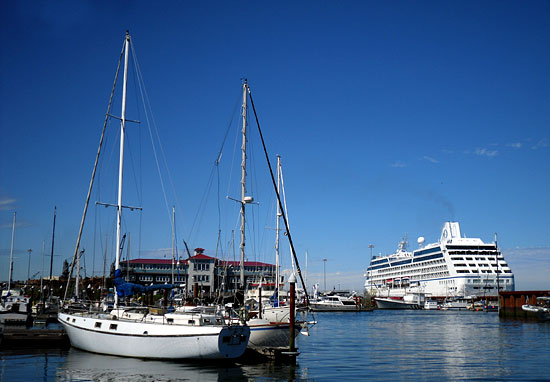 I zigged and zagged up those steep streets that meander hither-and-yon to the parking lot at the end of Coxcomb Drive where I was met by expansive views in three directions, out over the commercial district and across the Columbia to a hilly green strip of Washington state, out to sea beyond Warrington and Fort Stevens State Park, and south over inlets and sprawling pastures and forests still standing, and Fort Clatsop Lewis and Clark National Historical Park where the bone-tired men of the Discovery expedition wintered in 1805/06.
I zigged and zagged up those steep streets that meander hither-and-yon to the parking lot at the end of Coxcomb Drive where I was met by expansive views in three directions, out over the commercial district and across the Columbia to a hilly green strip of Washington state, out to sea beyond Warrington and Fort Stevens State Park, and south over inlets and sprawling pastures and forests still standing, and Fort Clatsop Lewis and Clark National Historical Park where the bone-tired men of the Discovery expedition wintered in 1805/06.
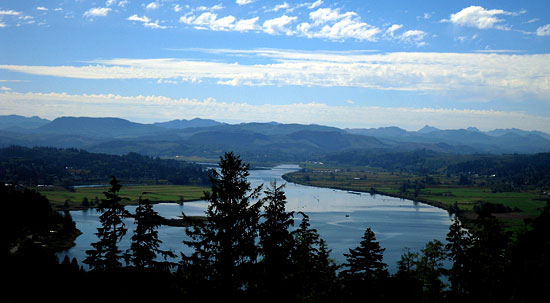 And then I looked down at my right hand where I held it, tenderly, watching it shrivel before my eyes, shrinking, vanishing. I wanted so much to put it to good use, maybe give it to someone in need. Share it with the less fortunate, perhaps, but they were probably down in the park sleeping it off. I couldn't get much with it anymore. After all, what's a dollar? Then I realized, hey, that's what they charge to park up here.
And then I looked down at my right hand where I held it, tenderly, watching it shrivel before my eyes, shrinking, vanishing. I wanted so much to put it to good use, maybe give it to someone in need. Share it with the less fortunate, perhaps, but they were probably down in the park sleeping it off. I couldn't get much with it anymore. After all, what's a dollar? Then I realized, hey, that's what they charge to park up here.
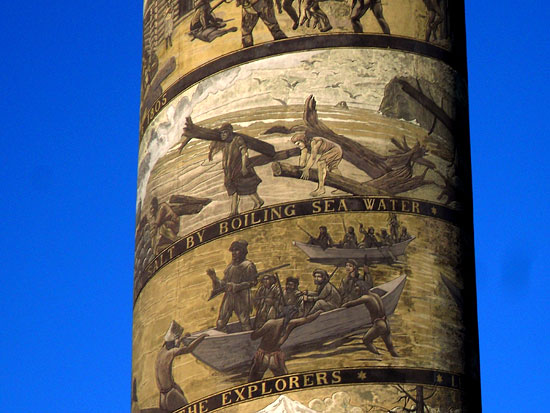 I didn't know what to make of the 125-foot-tall Astoria Column. Built in 1926 on behalf of the Great Northern Railway to promote travel and commerce, this “thing” has a long spiral staircase on the inside leading to even more expansive views and, on the outside, an Italian art form called Sgraffito. I'm spitting all over my keyboard trying to pronounce it – Brett Favre would know. Anyhow, this column is covered with fourteen 25-foot-long scenes depicting Northwest historical events that 400,000 visitors a year largely ignore or give up trying to decipher before slogging up and down those steps. Just so you know what you're in for, I snapped a photo from the bottom because that's about as close as I’ll ever get to the top of that “thing.” So says my stent.
I didn't know what to make of the 125-foot-tall Astoria Column. Built in 1926 on behalf of the Great Northern Railway to promote travel and commerce, this “thing” has a long spiral staircase on the inside leading to even more expansive views and, on the outside, an Italian art form called Sgraffito. I'm spitting all over my keyboard trying to pronounce it – Brett Favre would know. Anyhow, this column is covered with fourteen 25-foot-long scenes depicting Northwest historical events that 400,000 visitors a year largely ignore or give up trying to decipher before slogging up and down those steps. Just so you know what you're in for, I snapped a photo from the bottom because that's about as close as I’ll ever get to the top of that “thing.” So says my stent.

View Comments
John Treadwell Dunbar is a freelance writer